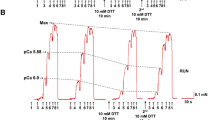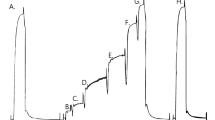Summary
Muscle biopsies were taken from the middle part of the vastus lateralis muscle of 9 men, who were not regularly involved in endurance training (M, average\(\dot V_{{\text{O}}_{\text{2}} } \) max=61.3 ml/min·kg), 3 sedentary women (W,\(\dot V_{{\text{O}}_{\text{2}} } \)max=43.7 ml/min·kg) and 5 well trained orienteers (TO,\(\dot V_{{\text{O}}_{\text{2}} } \) max=76.1 ml/min·kg). Morphometric analysis of 60 electron micrographs per biopsy gave the following significant differneces:
-
1.
The volume density of central mitochondria was 1.47-fold higher in TO than in M, and 1.44-fold higher in M than in W.
-
2.
The volume density of peripheric mitochondria was 3.22 times higher in TO compared to M.
-
3.
The ratio of the central mitochondrial volume to the volume of myofibrils was 1.54-fold higher in TO compared to M, while the respective ratio was 1.49 for M compared to W.
-
4.
The surface of the central mitochondria was 1.28-fold higher in TO than in M and 1.35-fold higher in M than in M.
-
5.
The surface of mitochondrial cristae was higher by a factor of 1.62 in TO compared to M and 1.35 in M compared to W.
-
6.
The central mitochondria were larger in TO compared to M by a factor of 1.12.
-
7.
The volume density of intracellular lipid (triglyceride droplets), was 2.5-fold higher in TO than in M.
There were highly significant correlations between\(\dot V_{{\text{O}}_{\text{2}} } \) max and volume density of central mitochondria (r=0.82), surface of mitochondrial cristae (r=0.80) and the ratio of mitochondrial volume to myofibrillar volume (r=0.78).
No quantitative changes could be observed in mitochondrial fine structure. Neither volume density of sarcoplasma nor volume and surface density of the tubular system showed any difference as a function of training and sex.
It is postulated that
-
a)
an individual's maximum oxygen intake is limited not only by the capacity of the oxygen transport system but also by the oxidative capacity of mitochondria in the skeletal muscles, and
-
b)
the skeletal muscle of trained athletes contains a much higher quantity of intracellular lipids (triglyceride droplets) as a substrate directly available for energy production.
-
a)
Similar content being viewed by others
References
Åstrand, P. O., Rodahl, K.: Textbook of work physiology. New York-St.Louis-San Francisco-London-Sydney-Toronto-Mexico-Panama: McGraw-Hill 1970
Barnard, R. J., Edgerton, V. R., Peter, J. B.: Effect of exercise on skeletal muscle. I. Biochemical and histochemical properties. J. appl. Physiol.28, 762–770 (1970)
Bergström, J.: Muscle electrolytes in man. Scand. J. clin. Lab. Invest.14, Suppl. 68 (1962)
Fawcett, D. W.: An atlas of fine structure; the cell, its organelles and inclusions. Philadelphia-London: W. B. Saunders 1966
Gnägi, H. R., Burri, P. H., Weibel, E. R.: A multipurpose computer program for automatic analysis of stereological data obtained on electron micrographs. In: P. Favard (Editor): Proc. 7th Int. Congr. Electron Microscopy, Vol. I. Paris: Soc. Française de Microscopie Electronique 1970
Gollnick, P. D., King, D. W.: Effect of exercise and training on mitochondria of rat skeletal muscle. Amer. J. Physiol.216, 1502–1509 (1969)
Gollnick, P. D., Januzzo, C. D., King, D. W.: Ultrastructural and enzyme changes in muscles with exercise. In: B. Pernow and B. Saltin (Edit.): Muscle metabolism during exercise. New York-London: Plenum Press 1971
Gollnick, P. D., Armstrong, R. B., Saubert, IV, C. W., Piehl, K., Saltin, B.: Enzyme activity and fiber composition in skeletal muscle of trained and untrained men. J. appl. Physiol.33, 312–319 (1972)
Gollnick, P. D., Piehl, K., Saubert IV, C. W., Armstrong, R. B., Saltin, B.: Diet, exercise, and glycogen changes in human skeletal muscle fibres. J. appl. Physiol.33, 421–425 (1972)
Hollmann, W.: Höchst- und Dauerleistungsfähigkeit des Sportlers. München: Joh. Ambr. Barth 1963
Holloszy, J. O.: Biochemical adaptations in muscle. Effects of exercise on mitochondrial oxygen uptake and respiratory enzyme activity in skeletal muscle. J. biol. Chem.242, 2278–2282 (1967)
Holloszy, J. O., Oscai, L. B., Don, I. J. Molé, P. A.: Mitochondrial citric acid cycle and related enzymes: adaptive response to exercise. Biochem. biophys. Res. Commun.40, 1368–1373 (1970)
Howald, H.: Eine Ergospirometrie-Anlage mit on line-Datenverarbeitung durch Mikrocomputer. Acta medicotech.21, 115–120 (1973)
Kiessling, K. H., Piehl, K., Lundquist, C. G.: Effect of physical training on ultrastructural features in human skeletal muscle. In: B. Pernow and B. Saltin (Edit.): Muscle metabolism during exercise. New York-London: Plenum Press 1971
Kraus, H., Kirsten, R., Wolff, J. R.: Die Wirkung von Schwimm-und Lauf-training auf die celluläre Funktion und Struktur des Muskels. Pflügers Arch.308, 57–79 (1969)
Luft, J. H.: Improvements in epoxy resin embedding methods. J. biophys. biochem. Cytol.9, 409–414 (1961)
Molé, P. A., Oscai, L. B., Holloszy, J. O.: Adaptation of muscle to exercise. Increase in levels of palmityl-CoA-synthetase, carnitine palmityltransferase, and palmityl-CoA-dehydrogenase, and in the capacity to oxidize fatty acids. J. clin. Invest.50, 2323–2330 (1971)
Morgan, T. E., Short, F. A., Cobb, L. A.: Alterations in human skeletal muscle lipid composition and metabolism induced by physical conditioning. In: J. R. Poortmans (Edit.): Biochemistry of exercise; medicine and sport, Vol. 3. Basel-New York: S. Karger 1969
Morgan, T. E., Cobb, L. A., Short, F. A., Ross, R., Gunn, D. R.: Effects of long-term exercise on human muscle mitochondria. In: B. Pernow and B. Saltin (Edit.): Muscle metabolism during exercise. New York-London: Plenum Press 1971
Oscai, L. B., Molé, P. A., Holloszy, J. O.: Effects of exercise on cardiac weight and mitochondria in male and female rats. Amer. J. Physiol.220, 1944–1948 (1971)
Palade, G. E.: A study of fixation for electron microscopy. J. exp. Med.95, 285 (1952)
Reynolds, E. S.: The use of lead citrate at high pH as an electron-opaque stain in electron microscopy. J. Cell Biol.17, 208 (1963)
Schmalbruch, H.: Die quergestreiften Muskelfasern des Menschen. In: Ergebnisse der Anatomie und Entwicklungsgeschichte, B. 43, Heft 1. Berlin-Heidelberg-New York: Springer 1970
Schönholzer, G., Bieler, G., Howald, H.: Ergometrische Methoden zur Messung der aeroben und anaeroben Kapazität. In: III. Int. Seminar für Ergometrie. Berlin 1972 (im Druck)
Weibel, E. R., Kistler, G. S., Scherle, W. F.: Practical stereological methods for morphometric cytology. J. Cell Biol.30, 23–38 (1966)
Weibel, E. R.: A stereological method for estimating volume and surface of sarcoplasmic reticulum. J. Micr.95, 229–242 (1972)
Author information
Authors and Affiliations
Additional information
Supported by grant 3.561.71 from Schweizerischer Nationalfonds zur Förderung der wissenschaftlichen Forschung.
Rights and permissions
About this article
Cite this article
Hoppeler, H., Lüthi, P., Claassen, H. et al. The ultrastructure of the normal human skeletal muscle. Pflugers Arch. 344, 217–232 (1973). https://doi.org/10.1007/BF00588462
Received:
Issue Date:
DOI: https://doi.org/10.1007/BF00588462




